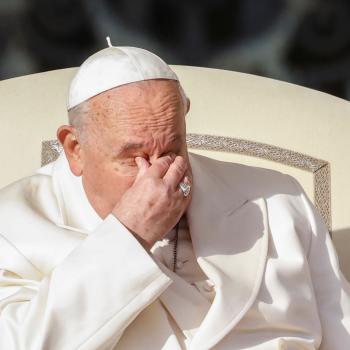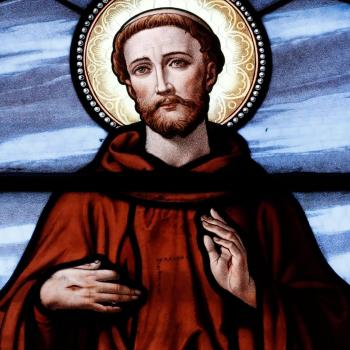There is a long, arduous, historical debate between Protestants and Roman Catholics, and among Protestants and among Catholics, on the role of tradition vis-a-vis the written Scriptures. Frequently in this debate, how tradition functions with regard to theological truth is obscured, misunderstood or strawmanned by both sides. Of course, this is in part due to the complexity of the question. Still, ignorance is never an entirely sufficient explanation for speaking untruthfully. Especially if one speaks such untruths repeatedly to attack an opponent. And so we must continuously investigate these issues. For clearly the sources of our knowledge about God matter with respect to our lives with God and with our neighbor.
Therefore, in order to get a better grasp of what role tradition plays in Evangelical Protestant theology, I will first provide a sketch of tradition as understood in Roman Catholicism. But this too is not easy, for there are two distinct views on the issue within the Roman Catholic Church itself. In practice, who holds which view, often comes down to who affirms the theological conclusions of The Second Vatican Council (1962-1965), and who rejects Vatican II’s teachings.
The Pre-Vatican II Understanding of Sacred Tradition
At the Council of Trent (1545-1563), which was the Roman Catholic Church’s official response to the challenges of the Protestant Reformers, the following dogmatic statement was made:
This truth and rule [of the Gospel] are contained in written books and [et] in unwritten traditions.
Council of Trent, Concilium Tridentinum diariorum, actorum, epistularum, tractatuum nova collection, ed. Societas Goerriesiana, 13 vols. (Freiberg: Herder, 1901-2001), 5:91
This dogmatic claim, a direct response to the Reformers who held that the truth and rule of the Gospel was contained only in Scripture (more on this later), is, however, ambiguous in one point. The conjunction “et” or “and” in English, made the statement difficult to interpret with regard to how the truth and rule of the Gospel are present in both the Scriptures and the Tradition.
Questions emerged in light of Trent’s claim: Are there Gospel truths contained in the unwritten (oral) traditions that are, or cannot be, found in the written books? If so, is the oral tradition a second source of revelation knowledge? If yes, then what are those revealed truths, and, are they then, as would be expected, binding on the believer? Finally, if they are binding on the believer, yet he or she is either ignorant of them, or worse, explicitly denies them, then what are the consequences for that person?
An earlier draft of the Council’s statement, eventually discarded, illuminates something about the authors of the statement’s intent. The earlier draft reads as follows:
This truth and rule [of the Gospel] are contained in part [partim] in written books and in part [partim] in unwritten traditions.
The now infamous “partim…partim” expression, and why it was changed, has caused great tumult over the nature of Tradition in the Roman Catholic Church for several centuries. However, it seems one likely reason it was changed from “partim…partim” to “et,” was to make it at least sound like there were no deficiencies in either source of Gospel knowledge. In other words, that there was nothing lacking in the Scriptures nor in the oral tradition. However, the final draft, the one that still stands, did not explicitly clarify whether or not there were two sources or only one source of revelation. And so there was no positive statement about whether, in fact, oral tradition must supplement the Scriptures, and, if they must, is the supplemental material that the Tradition provides necessary for salvation?
On one reading of the statement, the oral tradition that started with the Apostles (and ended with them) is passed on, and in that oral tradition there are revealed things not contained in the Scriptures. On another reading, the oral tradition that started with the Apostles (and ended with them) is passed on, but is itself not a source of revelation knowledge. It does not contain any revelatory material not also contained in the Scriptures. On this second view, Scripture alone is the substance of revelation, while the oral tradition acts more like an authoritative framework of interpretation. The Tradition on the latter view is, essentially, the right and only way to interpret the Bible. However, it is not like the Bible. The two are ontologically distinct, with tradition as the epistemic key to unlocking biblical knowledge.
Matthew Selby sums up what this ambiguity in the conciliar statement eventually lead to in Roman Catholic theology:
On the one side, there were proponents of what has been termed the “one-source theory” of revelation. These theologians claimed that the Tridentine decree, as a result of the change, allowed for a belief in the material sufficiency of Scripture, leaving Tradition as merely the authoritative interpretive context for Scripture. Thus, Scripture, as the one source of revelation, contains all truths necessary for salvation. On the other side, there were proponents of the “two- source theory” of revelation. These theologians contended that Trent explicitly excluded belief in the sufficiency of Scripture, arguing that the final decree still retained the meaning of the partim- partim formulation, despite the change in wording. Thus, they believed Scripture and Tradition function as two distinct sources of revelation. For them, Tradition contains part of revelation that is not contained in any way in Scripture, making Scripture insufficient regarding the truths necessary for salvation.
Selby, The Relationship Between Scripture and Tradition According to The Council of Trent, 2
One-Source and Two-Source Views Since Vatican II
This debate reached its peak at the Second Vatican Council where, it is thought at least, the “one-source” view eventually won out. This was in part due to the movement in Roman Catholic academic theology known as the ressourcement. The ressourcement movement was spearheaded by several 20th century biblical scholars– many French and Belgian, hence the French term. Their aim was to return to the sources of the biblical text itself and the earliest Christian witnesses to the Bible, in order to revision and repurpose those ancient insights for a modern world (aggiornamento). The idea was to “go backward in order to move forward.” This lead to a renewed and revitalized interest in critical biblical scholarship and the early Church Fathers. Many of the constitutions that came out of Vatican II owed their formulation to this dynamic, to include the move toward the “one-source” theory.
However, the text of Vatican II’s dogmatic constitution, Dei Verbum (Word of God) is also not absolutely clear on the issue at hand. It, like Trent, leaves it open as to whether the two-source theory is still valid:
Hence there exists a close connection and communication between sacred tradition and Sacred Scripture. For both of them, flowing from the same divine wellspring, in a certain way merge into a unity and tend toward the same end. For Sacred Scripture is the word of God inasmuch as it is consigned to writing under the inspiration of the divine Spirit, while sacred tradition takes the word of God entrusted by Christ the Lord and the Holy Spirit to the Apostles, and hands it on to their successors in its full purity, so that led by the light of the Spirit of truth, they may in proclaiming it preserve this word of God faithfully, explain it, and make it more widely known. Consequently it is not from Sacred Scripture alone that the Church draws her certainty about everything which has been revealed. Therefore both sacred tradition and Sacred Scripture are to be accepted and venerated with the same sense of loyalty and reverence.
Dei Verbum, Chapter II.9
Dei Verbum goes on to say, “Sacred tradition and Sacred Scripture form one sacred deposit of the word of God, committed to the Church.” These Vatican II statements seem to affirm the one source view, i.e., that the Tradition is not a separate source of revelation knowledge, but only an interpretive framework for the Scriptures, which themselves contain the sum total of all revelation knowledge. Yet, this is still contested by many Roman Catholics. And so the conflict between one-source Catholics and two-source Catholics continues to this day.
This conflict becomes especially poignant in light of certain dogmas of the Catholic church that seem impossible to find in Scripture, regardless of whether one has an infallible interpretive framework or not. One example of this would be the dogma of Mary’s bodily assumption into heaven. This belief was deemed binding on the conscience of every Catholic by Pope Pius XII’s ex cathedra proclamation, Munificentissimus Deus. This dogmatic pronouncement occurred just twelve years before Vatican II, in 1950.
The main proponent of the one-source view leading up to Vatican II was the German theologian Joseph Geiselmann. In a 1956 paper, Geiselmann proposed that Trent had been woefully misinterpreted by the Counter-Reformers. Geiselmann vigorously argued that the Scriptures alone were sufficient, and that the reason the first draft of the Tridentine statement was dropped was to reflect exactly this point. The problem being that, in their fervor to answer the Reformers’ principle of sola scriptura, Counter-Reformers like Peter Canisius and Robert Bellarmine (Selby, 7) chose to interpret the ambiguity of the latter statement in the “partly…partly” fashion.
However, when charged with sounding too Protestant in his views, Geiselmann responded defensively, saying that while the Scriptures are materially sufficient, they are not formally sufficient. In other words, apart from the Tradition, the Scriptures cannot be properly interpreted, and, as such, heresy (or fractioning over subjective interpretations) is inevitable.
In sum, it seems the predominant view today, although it is by no means the consensus view among Catholics, is that Tradition is not itself a source of revelation. Instead it is the formal, authoritative framework of interpretation that the Magisterium of the Catholic Church, with the Pope as its head, uses to rightly promulgate, safeguard, teach and explicate that which is actual revelation, namely the Scriptures. However, from the time of Trent until Vatican II this was not the majority view. Before Vatican II, the two-source theory, where Scripture is supplemented by some necessary revelatory material contained in oral tradition alone, was the majority view.
The (Much Maligned) Protestant Principle of Sola Scriptura
The challenge to Geiselmann by two-source Catholics in the lead-up to Vatican II was telling. For in arguing against Geiselmann, two-source adherents were also defending a much stronger distinction between Roman Catholic theology and Protestant theology, at least with regard to revelation. Of course, in arguing for a stronger contrast between theologies, two-source Catholics were also arguing for a stronger contrast between Catholics and Protestants. Geiselmann’s view began to sound almost like the Protestant principle of sola scritpura, in that the traditions of the Church are the means by which the Bible is rightly interpreted, but they are not equal to the Bible. This did not sit well with some two-source Catholics.
Of course, the principle of sola scriptura is often misunderstood, and very much maligned, by Roman Catholics. The average Roman Catholic tends to think that sola scriptura means something like “solo” or “nuda” scriptura, that is the Bible “only” or “alone,” as in “entirely separate from all other sources of authority.” But this was never the intent of the Reformers, and is a complete strawman of the Protestant principle, one still spewed today by woefully uninformed Catholics. Unfortunately, there are enough Evangelicals equally ignorant of the principle to make the Roman Catholic accusation appear justified.
Tradition, therefore, is an authority for the Protestant. Sola Scriptura only says that all other Christian proclamations, whether written or spoken (or given through sign language), must be gauged against the infallible words of the Bible. The difference between Geiselmann’s view, and later of Benedict XVI, and the Reformers’ view, is that the Protestant principle does not also affirm that the tradition itself is infallible. That means that if the community of the Church over time came to realize that some prior theological judgement of the Church was wrong, it could only be in light of the Scriptures that this could even be seen, let alone adjudicated. It is not the present cultural conditions, therefore, that overturn prior judgments of the Church. This is in spite of the fact, as in the Vatican II sense of aggiornamento, that prior theological judgments might need to be articulated afresh for a different cultural generation. But changing the way one says a theological proposition is not the same as changing the truth value of its propositional content.
The Methodist theologian, Thomas Oden, explains this dynamic well:
Theology builds progressively upon previous generations of the study of God, using stores of wisdom both old and new (Matt. 13:52; Augustine, Sermon 74.5). Rediscovered insights into Scripture and tradition keep coming to the attention of the church at unexpected times (Cyril of Alexandria, Fragment 172, Reuss, MKGK 209). Each age has the possibility of contributing something to the storehouse for subsequent ages that will study God, yet that fact does not imply that the received faith itself is being substantively changed from generation to generation (Simplicius, The Unchangeableness of Chr. Doctrine, SCD 160).
Oden, Classic Christianity, 179
As such, the Reformers were adamant about reading the Bible both synchronically (within the present community of the Church) and diachronically (together with the Christian community of the past). The Reformers were the first ressourcement theologians, desiring to return not only to the Scriptures, but also to the earlier commentaries on the Scriptures, those of the Church Fathers. Of course, in addition to tradition and the present community of the Church, there is one other authority that Catholics hesitate to speak of, but that Protestants boldly affirm, that being the Spirt of God Himself; at least, the Spirt of God at work in the individual believer. Obviously Roman Catholics do believe that the Holy Spirit ensures right illumination of the Scriptures. However, that “infallible charism” is reserved strictly for the teaching Magisterium of the Roman Catholic Church. It is not granted to the individual follower of Christ.
Why Does the Formal Principle Matter?
In conclusion then, the real difference between the “one-source” view of tradition as found in the newer theology of the Roman Catholic Church, and alluded to in the Vatican II constitution, Dei Verbum, and the Protestant principle of sola scriptura does not relate directly to Scripture. Rather, it relates to who, or what, possesses the infallible, and authoritative guide for scriptural interpretation. It has to do with what specifically is the authoritative, infallible source of theological knowledge. It is one thing, two things or perhaps even three things?
Here is where the material rubber meets the formal road: both the Roman Catholic Church and the Reformers agreed that salvation came through faith in Jesus Christ, that was the matter of salvation, or the material principle. However, the formal principle, the infallible “foundation of knowing and formal object of faith and of revealed theology” (Muller, 52) was for the Reformers the Scriptures alone. For Roman Catholics, the formal principle is the infallible Scriptures, the infallible Tradition and the infallible Magisterium of the Catholic Church all taken in concert.
It is on account of the three-fold formal principle, however, that the material principle of “salvation through faith in Jesus Christ” for the Catholic Church is not the same as it is for the Reformation churches. And as Calvin declared, it was this difference in the understanding of how we are saved, also known as the doctrine of justification, that was “the hinge” on which the entire Reformation swung. Therefore, all other discrepancies in dogmatic claims, be they about Mary, the Sacraments, Purgatory, etc., hinge on the doctrine of justification by faith (alone).
In the next post, I will discuss problems with both the Protestant and the Catholic views of authority and interpretation.














